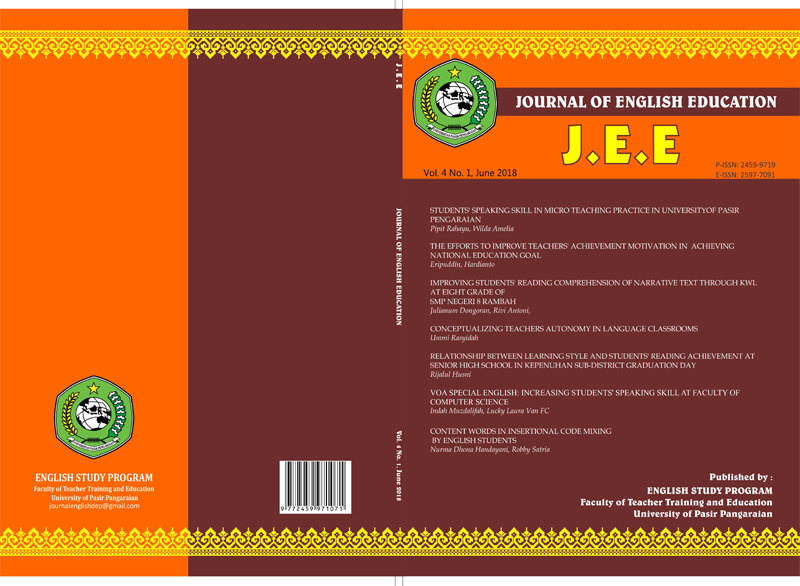CONCEPTUALIZING TEACHERS AUTONOMY IN LANGUAGE CLASSROOMS
Keywords:
Attributes, Autonomous, Concept, Engagement, Language Classroom.Abstract
The focus of this paper is on learner autonomy (henceforth, LA) in language classroom setting. LA is an engagement in a process of reflective practice in learning process. In what follows, I will first discuss concisely the concept of LA; next I will briefly discuss the work of possible differences among attributes affecting LA; finally, I will elaborate LA for language classroom, and will suggest how LA might be conceptualized according to LA principles. In the language classroom, LA is usually associated either with students or teachers. Moreover, LA as it stands for, generally considered as encouraging students to become more autonomous. Following Nasri, Dastjerdy, Rasekh and Amirian (2015), however, I suggest that gender, background, and experience as a valuable feature contribution to promote LA.References
Alibakhsi, G. 2015. Challenges in Promoting EFL Learners‟ Autonomy: Iranian EFL Teachers‟ Perspectives. Issues in Language Teaching, 4(1), 79-98.
Arabski, J. 1999. Gender Differences in Language Learning Strategy Use: A Pilot Study. In B. Mibler and U. Multahaup (Eds.), The Construction of Knowledge, Learner Autonomy and Related Issues in Foreign Language Learning. Tubingen: Stauffenburg Verlag.
Balcikanli, C. 2010. Learner Autonomy in Language Learning: Student Teachers‟ Belief. Australian Journal of Teacher Education, 35(1), 90-103.
Benson, P. 1997. The Philosophy and Politics of Learner Autonomy. In P. Benson & P. Voller (Eds), Autonomy and Independence in Language Learning (18-34). London: Longman.
Benson, P. 2001. Teaching and Researching Autonomy in Language Learning. Harlow: Longman.
Benson, P. 2006. Autonomy in Language Teaching and Learning. Language Teaching, 40(1), 21-40.
Benson, P. and Huang, J. 2008. Autonomy in the Transition from Foreign Language Learning to Foreign Language Teaching. D.E.L.T.A., 24, 421-439.
Dam, L. 2009. The Use of Logbooks- A Tool for Developing Learner Autonomy. In R. Pemberton, S. Toogood, and A. Barfield (Eds.), Maintaining Control: Autonomy and Language Learning. Hong Kong: Hong Kong University Press.
Ellis, R. 2010. Epilogue: A Framework for Investigating Oral and Written Corrective Feedback. Studies in Second Language Acquisition, 32, 335-346.
Hafner, C.A., and Miller, L. 2011. Fostering Learner Autonomy in English for Science: A Collaborative Digital Video Projects in a Technological Learning Environment. Language Learning and Technology, 15(3), 68-86.
Harmer, J. 2001. The Practice of English Language Teaching. Essex: Longman.
Holec, H. 1981. Autonomy and Foreign Language Learning. Pergamon. Oxford.
Holliday, A. 2013. Social Autonomy: Addressing the Dangers of Culturism in TESOL. In D. Palfreymen & R. Smith (Eds.), Learner Autonomy across Cultures Language Education Perspectives (110-126). New York: Palgrave Macmillan.
Joshi, K. R. 2011. Learner Perceptions and Teacher Beliefs about Learner Autonomy in Language Learning. Journal of NELTA, 16(1-2), 13-29.
Kocak, A. 2003. A Study on Learner‟s Readiness for Autonomous Learning of English as Foreign Language. Unpublished MA Thesis, Middle East Technical University.
Lantolf, J. P., and Thorne, S. L. 2006. Sociocultural Theory and the Genesis of Second Language Development. Oxford, England: Oxford University Press.
Lee, M. K. 2017. To be Autonomous or not to be: Issues of Subsuming Self-Determination Theory into Research on Language Learner Autonomy. TESOL QUARTERLY, 51(1), 220-228.
Little, D., Hodel, H., Kohonen, V., Meijer, D., and Perclova, R.2007. Preparing Teachers to Use the European Language Portfolio-Arguments, Materials, and Resources. Strasbourg Cedex: Council of Europe Publishing.
Lou, N. M., Chaffee, K. E., Lascano, D. I. V., Dincer, A., and Noels, K.A. 2018. Complementary Perspective of Autonomy in Self-Determination Theory and Language Learner Autonomy. TESOL QUARTERLY, 52(1), 210-220.
McGrath, I. 2000. Teacher Autonomy. In B. Sinclair, I. McGrath, and T. Lambs (Eds.). Learner Autonomy, Teacher Autonomy: Future Directions. Harlow, England: Pearson Education.
Nasri, N., Dastjerdy, H.V., Rasekh, A.E., and Amirian, Z. 2015. Iranian EFL Teachers‟ Practices and Learner Autonomy: Do Gender, Educational Degree, and Experience Matter? Innovation in Language Learning and Teaching, Retrieved from http://dx.doi.org/10.1080/17501229.2015.10788337.
Norton, B. 2000. Identity and Language Learning: Gender, Ethnicity, and Educational Change. Harlow, England: Longman.
Oxford, R. L. 2003. Toward a More Systematic Model of L2 Learner Autonomy. In D. Palfreymen & R. Smith (Eds.), Learner Autonomy across Cultures Language Education Perspectives (75-91). New York: Palgrave Macmillan.
Pawlak, M. 2014. Error Correction in the Foreign Language Classroom: Reconsidering the Issues. Heidelberg, New York: Springer.
Riley, P. 1997. The Guru and the Conjurer: Aspects of Counseling for Self-Access. In P. Benson, & P. Voller (Eds), Autonomy and Independence in Language Learning (114-131). New York: Longman
Schwienhorst, K. 2003. Learner Autonomy and CALL Environments. New York: Routledge.
Varol, B., and Yilmaz, S. 2010. Similarities and Differences between Female and Male Learners: Inside and Outside Class Autonomous Language Learning Activities. Procedia Social and Behavioral Sciences, 3, 237-244.
Xu, Jianping. 2009. Survey Study of Autonomous Learning by Chinese Non-English Major Post-Graduates. English Language Teaching, 2(4), 25-32.
Yan, S. 2012. Teacher Roles in the Learner-Centred Classroom. ELT Journal, 47(1), 22-31.
Zhuang, J. 2010. The Changing Role of Teachers in the Development of Learner Autonomy-Based on a Survey of “English Dorm Activity, Journal of Language Teaching and Research, 1(5), 591-595.




